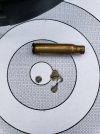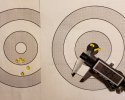So, fire all 60 cases in a match yesterday. We had some new steel disc targets made that are sized to be 3 minutes in diameter at the various yardages we shoot. Yesterday was 10 rounds each at 200, 300 and 400 yds with 2 offhand shots at a coyote set at 500. One shooter hit the coyote using a Hungarian PU sniper rifle, complete with original Russian sniper scope.
I had weighed all my bullets to remove that variable. Kept them within =/- 0.5 gr. My groups were good when I did my job. Those 3 minute targets are separating the men from the boys and the good rifles from the great rifles, good loads nothwithstanding.
I had no flyers. The primary condition yesterday was a mirage that was going from L-R and then R-L. There was a mild head wind, but not enough to make a difference. It was -3F when I got to the club and the wind flags were a tad on the crispy side for the first relay. I warmed them up with my hands and they showed some very mild breezes. I started at 400 and missed 2. First shot for score hit the berm at 9:00 with no room. I put a half minute right into the scope and cleaned the next 8. Due to a brain phardt on my part, I only shot 9 rounds and thought I'd shot 10. My spotter was sure he'd not missed scoring a shot. I realized my mistake and took my rifle back out of the rack and proceeded to miss the last shot, again, with no room. Conditions had changed and both of us failed to notice. My brain may have played a role in that miss as well.
When I got home, I tossed the brass into the tumbler and once clean went at them with the small hole gauge. Since using that is a bit of a pain for multiple measurements, I moved to checking the OD of the necks with a mic and found the following.
48 cases - 0.342-0.3425
12 cases - 0.341 - 0.342
Within those ranges the cases were not 100% round. They varied within that range and some of the 12 small ones ended up there because they varied below 0.3410. I would expect the bullet to give and the OD of the case to match the chamber shape in the case of thickness variation within the neck wall. So, it would appear that my chamber is not perfectly round, at least in the neck/throat area.
After doing this I set the small hole gauge to a snug slip fit in a case and then ran it thru all the others. All but a couple had the same feel. My suspicion on the OD variation is either the brass is a tad thinner or the smaller OD cases were shot in the cold rifle for the first relay. Although my rifle goes from the house to a heated vehicle, it was meat locker cold inside the enclosed firing line until we got the wood stove and propane furnace cranked up. So, I suspect my rifle had cooled down prior to the first shots.
The neck IDs I did measure were in the 0.313 - 0.3135 range. My bullet measures 0.3140 so that makes for very little neck tension. I'd like to see 0.002 - 0.003 interference fit. So, my hope to avoid neck sizing was defeated by my chamber dimensions.
My plan is to move to a .303 British collet neck sizer. Using the mandrel dimensions for my .30-06 sizer, I suspect that the mandrel for the .303B will be 0.312. I have a question into Lee asking that question. That should be perfect for my purposes. I have a brand-new collet/mandrel set that Lee sent me when the original started to show wear and was sticking closed and ruining the next case. I thought about opening up the hole in the closer and machining a bigger mandrel. But for the price of a .303B die, simply buying a new die is probably the better route.
A side note on those Lee collet neck sizers. They are NOT hardened. So, if you do not lube them, and I'm not sure that will do much other than prolong the inevitable, they will wear and start to stick. After I got my replacement parts from Lee, I took the old set and polished out the wear on my lathe. Then I case hardened both parts and repolished. They work great and there is no signs of wear or sticking. I do use STP as a lube for the collet to closer surfaces. Bill Wilson mentioned using that on sears in his book some 30 years ago and I've been using it for sears and other sliding high pressure contact surfaces like this since.


